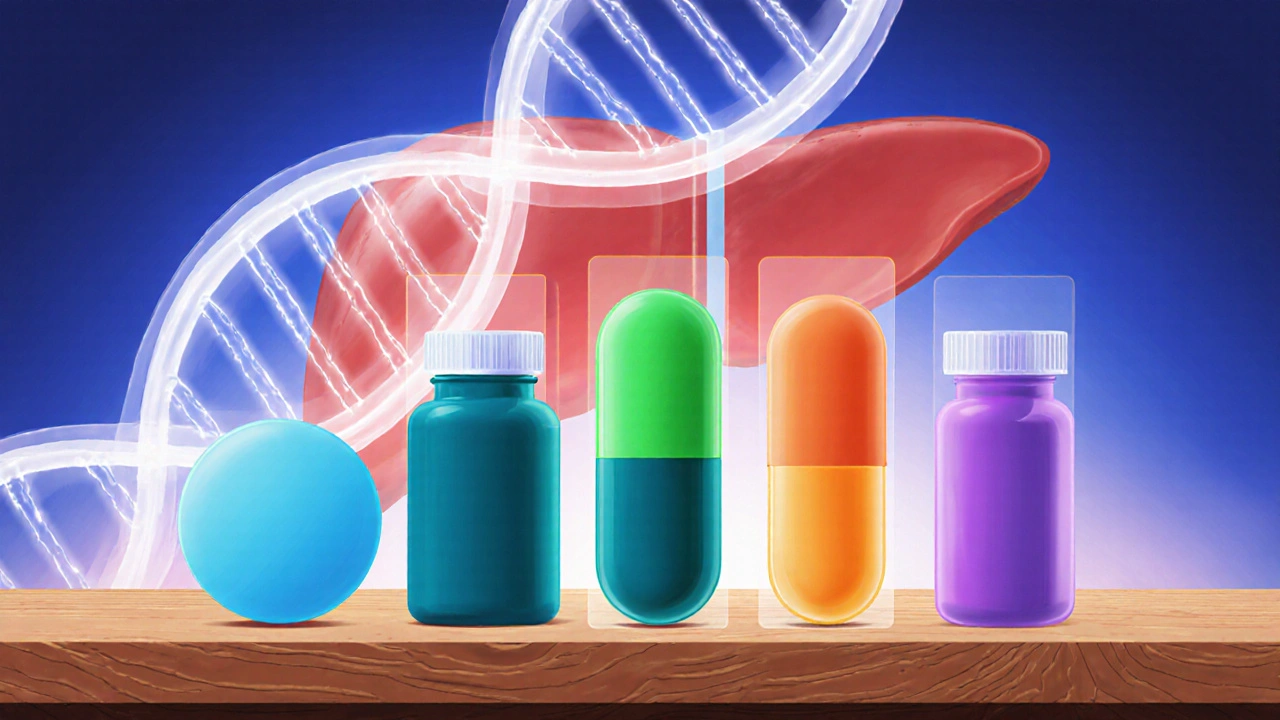HBV Drug Comparison Tool
This tool compares key attributes of Lamivudine (Epivir HBV) and major HBV treatment alternatives. Select a drug to see detailed information.
| Attribute | Value |
|---|
When you or a loved one is diagnosed with chronic hepatitis B, the first question is usually “which medicine works best?” Epivir HBV is the brand name for Lamivudine, a nucleoside analogue that has been on the market for decades. It’s cheap, taken once daily, and has a solid safety record, but newer drugs promise higher viral suppression and lower resistance risk. This guide breaks down the most common alternatives, weighs their strengths, and helps you decide what fits your health goals and lifestyle.
Key Takeaways
- Lamivudine is affordable and well‑tolerated but has a low genetic barrier to resistance.
- Tenofovir (both TDF and TAF) offers the strongest viral suppression with minimal resistance.
- Entecavir is a close competitor to Tenofovir, especially for patients with mild renal impairment.
- Cost, kidney health, and pregnancy status often tip the balance between drugs.
- Regular blood monitoring is essential no matter which antiviral you choose.
What is Lamivudine (Epivir HBV)?
Lamivudine is a synthetic cytidine analogue that interferes with the hepatitis B virus (HBV) polymerase, stopping the virus from copying its DNA. It received FDA approval in 1998, making it one of the first oral HBV treatments.
Typical dosing is 100mg once a day, taken with or without food. Because it’s a small molecule, the drug is eliminated primarily through the kidneys, so people with severe renal failure need dose adjustments.
Pros:
- Low price - often the cheapest option on the market.
- Simple once‑daily regimen.
- Excellent safety profile; side‑effects are usually mild (headache, nausea).
Cons:
- Resistance can develop after 1-2years in up to 20% of patients.
- Viral suppression is modest compared with newer agents.
- Does not address kidney‑related safety concerns for long‑term use.
How Nucleos(t)ide Analogues Work
All the drugs we’ll compare belong to the class of nucleos(t)ide analogues. They mimic the natural building blocks of HBV DNA, get incorporated by the viral polymerase, and cause chain termination. The key differences lie in their chemical structure, how tightly they bind to the polymerase, and the virus’s ability to mutate around them.
Understanding the "genetic barrier" - how many mutations the virus needs to become resistant - helps explain why older drugs like Lamivudine fall behind newer ones.
Major Alternatives to Lamivudine
Below are the most widely prescribed alternatives, each with its own profile.
Tenofovir disoproxil fumarate (TDF) is a nucleotide analogue introduced in 2001. It has a high barrier to resistance and strong viral suppression, but can affect kidney function over time.
Tenofovir alafenamide (TAF) is a newer pro‑drug of Tenofovir that delivers the active molecule more efficiently to liver cells, reducing kidney and bone side‑effects.
Entecavir received FDA approval in 2005. It offers powerful suppression with a resistance profile similar to Tenofovir but with a lower dose (0.5-1mg daily).
Adefovir dipivoxil is an older nucleotide analogue that is rarely used today because of modest efficacy and higher nephrotoxicity.
Finally, Hepatitis B virus (HBV) itself is a DNA virus that can cause chronic liver inflammation, cirrhosis, and liver cancer if not adequately controlled.

Side‑Effect Snapshot
- Lamivudine: fatigue, headache, occasional nausea; rare renal issues.
- TDF: possible decrease in eGFR, phosphate wasting, bone mineral loss.
- TAF: milder renal impact, minimal bone loss, occasional weight gain.
- Entecavir: well‑tolerated; rare lactic acidosis in patients with mitochondrial disorders.
- Adefovir: higher risk of kidney tubular dysfunction, especially at higher doses.
Direct Comparison Table
| Drug | Brand (if any) | Mechanism | Resistance Barrier | Dosing Frequency | Renal Safety | FDA Approval Year | Typical Monthly Cost (USD) |
|---|---|---|---|---|---|---|---|
| Lamivudine | Epivir HBV | Nucleoside analogue | Low | Once daily | Generally safe; dose‑adjust if eGFR<30mL/min | 1998 | $15-$25 |
| Tenofovir disoproxil fumarate | Viread | Nucleotide analogue | High | Once daily | Monitor renal function; caution if eGFR<60mL/min | 2001 | $30-$45 |
| Tenofovir alafenamide | Vemlidy | Nucleotide analogue (pro‑drug) | High | Once daily | Better renal & bone profile than TDF | 2015 | $70-$90 |
| Entecavir | Baraclude | Nucleoside analogue | High | Once daily | Renally safe; dose‑adjust if eGFR<50mL/min | 2005 | $45-$60 |
| Adefovir dipivoxil | Hepsera | Nucleotide analogue | Moderate | Once daily | Higher nephrotoxicity; avoid if eGFR<80mL/min | 2002 | $20-$30 |
How to Choose the Right Medication
Picking a drug isn’t just about “which one is cheapest.” It’s a balance of viral suppression, safety, lifestyle, and long‑term goals.
- Kidney health matters. If you have chronic kidney disease (CKD), TAF or Entecavir may be safer than TDF or high‑dose Lamivudine.
- Pregnancy considerations. Lamivudine and Tenofovir are both Category B (generally safe). Entecavir lacks extensive pregnancy data.
- Resistance risk. If you’ve been on Lamivudine for more than a year, a resistance test is wise before switching.
- Cost & insurance. In many countries, Lamivudine remains the most reimbursable option. However, when factoring in future liver‑related complications, the higher up‑front cost of TAF can be cost‑effective.
- Convenience. All listed drugs are once‑daily, but some patients prefer a single‑pill regimen that combines Tenofovir with other antivirals for HIV‑co‑infection.
Discuss these points with your hepatologist or primary care provider. Blood work (HBV DNA levels, ALT, eGFR) every 3-6months will guide adjustments.
Managing Resistance and Treatment Failure
If HBV DNA rebounds while you’re on Lamivudine, the virus most likely acquired an M204V/I mutation. In that case, guidelines suggest adding or switching to Tenofovir or Entecavir. Combining two agents is an option for patients with multi‑drug resistance, but insurance approval can be a hurdle.
Regular monitoring is crucial. A sudden rise in ALT or HBV DNA should trigger a resistance test. Early detection keeps you from progressing to cirrhosis or hepatocellular carcinoma.

Practical Checklist Before Starting Therapy
- Confirm chronic HBV diagnosis (HBsAg+>6months).
- Assess baseline labs: HBV DNA, ALT, liver ultrasound, eGFR, bone mineral density if older.
- Discuss pregnancy plans, renal health, and any co‑existing HIV or HCV infection.
- Review insurance coverage and out‑of‑pocket cost.
- Choose initial agent based on the factors above.
- Schedule follow‑up labs at 3months, then every 6-12months.
Frequently Asked Questions
Frequently Asked Questions
Can I switch from Lamivudine to Tenofovir without a break?
Yes. Most clinicians advise a direct switch, keeping the same dosing time. A short overlap isn’t needed, but you should repeat HBV DNA testing 3months after the change to confirm suppression.
Is Lamivudine safe for people with mild kidney disease?
Generally, yes, but the dose should be reduced if your eGFR is below 30mL/min. Your doctor will calculate the exact amount based on your lab results.
Why do some doctors still prescribe Lamivudine in 2025?
Cost is a big driver. In low‑resource settings or for patients without insurance, Lamivudine may be the only affordable option. It also works well for short‑term suppression before a more potent drug becomes accessible.
Do I need to take medication for life?
Most chronic HBV patients stay on antiviral therapy indefinitely because stopping can cause a flare. Exceptions exist if you achieve sustained HBsAg loss, which is rare (<5% with current drugs).
Can I drink alcohol while on Lamivudine?
Alcohol doesn’t interact directly with Lamivudine, but heavy drinking worsens liver inflammation. Moderation is key-limit to no more than one drink per day for women and two for men.
Bottom Line
If you need a budget‑friendly, well‑tolerated antiviral and your kidney function is normal, Lamivudine remains a viable choice. However, for most patients the superior viral suppression and resistance profile of Tenofovir (especially the TAF formulation) or Entecavir make them the preferred first‑line options. Use the comparison table and checklist above to talk confidently with your healthcare provider about the best fit for your situation.

Randy Pierson
October 8, 2025 AT 16:07